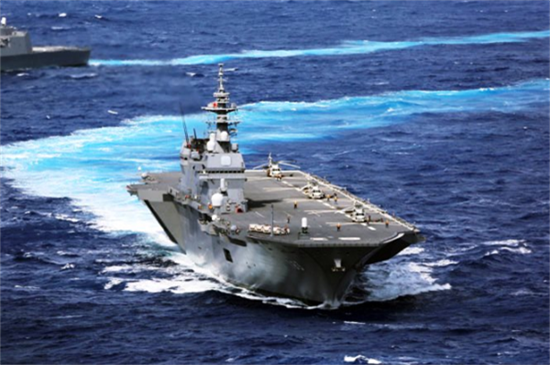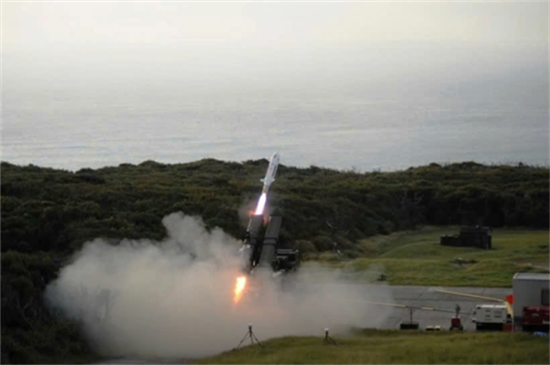Amid growing complexities in the global and regional security environment, Japan has been accelerating the modernisation of Japan Self-Defence Forces (JSDF) through a series of crucial steps. With the adoption of new national security and defence strategies, along with a significant increase in defence investment, Japan’s defence equipment modernisation is reshaping the regional military balance, which has drawn considerable attention from military analysts.
According to international researchers, the primary driving force behind the wave of defence equipment modernisation lies in the Japanese government’s approval of three key strategic documents at the end of 2022, namely the National Security Strategy, the National Defence Strategy, and the Medium-Term Defence Programme.
 |
| A helicopter destroyer of the Japan Maritime Self-Defence Force (photo: Wikipedia) |
Notably, the historic change is that for the first time since the end of World War II, Japan has adopted the policy of possessing a “counter-strike capability”, allowing the JSDF to attack enemy missile bases and command centres in the event of an attack or a clear threat of being attacked. To realise this policy, Tokyo has increased its defence budget and set a goal of raising defence spending to 2% of GDP by 2027. Japan’s 2025 Defence White Paper also highlights what it calls a “new era of crisis”, underscoring escalating security challenges from neighbouring countries and reaffirming the urgency of modernising defence equipment to strengthen deterrence capabilities. The above-mentioned reasons form the foundation for Japan to promote the modernisation of its defence equipment comprehensively across the three services: the Japan Ground Self-Defence Force (JGSDF), the Japan Maritime Self-Defence Force (JMSDF), and the Japan Air Self-Defence Force (JASDF), with a focus on several key programmes as follows.
Enhancing Aircraft Carrier Capabilities
In order to meet the requirements of an active defence strategy, aircraft carriers and carrier-based fighter jets have become a central focus in the process of modernising defence equipment of the JSDF. One of the most notable steps towards realising this strategy is the decision to convert the Izumo-class helicopter destroyer into a fully operational aircraft carrier capable of accommodating F-35B stealth fighter jets. Japan’s determination to pursue this programme was further reinforced after the United States' F-35B fighters had been successfully deployed from the amphibious assault ship USS Essex to strike targets in Afghanistan and safely returned in September 2018.
The Izumo measures 248 metres in length and has a full-load displacement of 27,000 tons, comparable to the British Royal Navy’s Invincible-class carriers. After being upgraded with the latest technologies in electronic warfare, fire-control, and radar systems, the vessel is expected to be capable of participating in any modern conflict of the 21st century. Moreover, the Izumo can significantly enhance Japan’s offensive operations, as it is capable of carrying up to 400 marines and nearly 50 military vehicles.
Japan has equipped the multirole tiltrotor aircraft V-22 Osprey and plans to deploy more F-35B fighter jets aboard the Izumo-class carriers. The Japanese government has purchased 42 F-35B aircraft for carrier-based operations, which are capable of short take-off and vertical landing. Each Izumo-class carrier, once fully modified, will be able to accommodate up to eight F-35B fighters. Thus, with an ambition to operate five Izumo-class carriers, Japan will possess very strong maritime attack capabilities. During World War II, the Imperial Japanese Navy once owned ten aircraft carriers, the world’s largest and most advanced carrier fleet at that time. Apart from the United States, Japan remains the only nation to have engaged in large-scale naval warfare using aircraft carriers. According to military analysts, the potential deployment of five Izumo-class carriers represents not only a significant expansion of Japan’s maritime strike power but also serves as a strategic signal to rival countries, affirming that Japan remains one of the world’s major naval powers.
Focusing on developing hypersonic missiles and long-range cruise missiles
According to international researchers, following the ambition to develop aircraft carrier fleet, Tokyo is now pursuing a hypersonic weapons development programme. Japan’s Ministry of Defence has outlined the “Research and Development Vision towards the realisation of a multi-domain defence force and beyond". Accordingly, hypersonic weapon systems are being developed, including hypersonic velocity glide projectiles (HVGP) and hypersonic cruise missiles (HCM). Japan will integrate these new missiles into its F-3 sixth-generation fighters, replacing the existing F-2 fighters. At the “Fuji Firepower Exercise 2025”, the JGSDF showcased HVGP missile systems for the first time. This is a domestic product of Japan’s defence industry, developed by Mitsubishi Heavy Industries. The HVGP, also described as a “hypersonic velocity glide projectile”, is a hypersonic weapon developed for island defence with the capability to strike adversary bases. The current HVGP version has a range of about 900 km, with subsequent variants expected to extend to 2,000 - 3,000 km. The HVGP can reach a maximum speed of 5 times the speed of sound (Mach 5), and is guided by satellite navigation combined with an integrated GPS/INS inertial navigation system. Its aerodynamic design provides high manoeuvrability and enables in-flight trajectory changes to reduce vulnerability to interception.
 |
| Japan’s hypersonic velocity glide projectile - HVGP (photo: Kyodo) |
In addition, Japan is focusing on the research and development of long-range cruise missiles that can be launched from land, sea, and air platforms. The new surface-to-ship cruise missile project was initiated in 2018, and by 2023, Japan successfully developed a prototype of a multirole long-range missile featuring a low radar cross-section and high manoeuvrability. The "new SSM" is capable of striking targets at extended ranges, from about 1,000 km in the standard version to up to 2,500 km in the extended-range version. It will be deployed to coastal anti-ship units of JMSDF, complementing the short-range Type 80 and older Type 12 systems. With its land-attack capability, the "new SSM" will enable Japan to reduce its dependence on Tomahawk cruise missiles purchased from the US. The development and deployment of long-range missile systems reflect a fundamental shift in Japan’s defence policy, from a purely defensive strategy to an active deterrence one. The deployment of the "new SSM" will enable Japan to establish a defensive belt along the first island chain, enhancing its ability to control strategic areas and deter potential incursions, while providing the capability to conduct pre-emptive strikes against enemy missile bases and command centres.
Collaboration in research and development of new generation fighter aircraft
According to international observers, Japan’s medium-term defence programme, launched at the end of 2022, aims to build the necessary capabilities to protect Tokyo’s interests in areas, such as outer space, cyberspace, electronic warfare, and to enhance the interoperability among military forces. By 2027, Japan should be able to take primary responsibility for dealing with invasion wars, with the capacity to deter and defeat threats to its sovereignty and national interests while still retaining allied support. Japan’s commitment to independent self-defence is clearly reflected in its defence cooperation with the United States.
Military experts believe that although Japan’s defence industry is highly competitive in technology, it remains relatively small, with limited export experience, and Tokyo tends to favour protecting its domestic industry through preferential contracts. Meanwhile, US defence industry firms worry about potential profit losses, the transfer of sensitive technologies, and being replaced by Japanese companies in the key supply chain. The modern military aviation industry is extremely difficult to restart after a long interruption, because experienced engineers have retired, factories have closed, and technologies have become obsolete. Therefore, if Japan does not begin developing a stealth fighter now, it will be incapable of implementing the F-3 programme in the future and will foreclose Tokyo’s hopes of breaking long-standing dependence on US defence companies.
Despite various challenges, Japan remains determined to pursue the development of next-generation fighter aircraft programme and aims to create an optimal design. Recently, Japan rejected Lockheed Martin’s proposal for a hybrid model combining features of the fifth-generation stealth fighters F-22 and F-35, arguing that developing from existing fighters cannot qualify as a candidate for the sixth-generation F-3 programme. At present, Tokyo seeks to leverage the technological expertise of the US company Northrop Grumman, known for its stealth fighter design XF-23, and the UK company BAE Systems, which is currently developing the Tempest stealth fighter. However, both options would only enable Japan to produce a fifth-generation fighter instead of pursuing a sixth-generation fighter design. The Japan - US joint research and development programme for the sixth-generation F-3 fighter, though facing significant difficulties, is being urgently advanced due to its long-term strategic importance in strengthening military capabilities. The success of this programme would symbolise a new milestone in defence research and development cooperation based on the alliance framework.
International public opinion holds that Japan’s determination to modernise its defence equipment on grounds of enhancing defence capabilities has generated mixed reactions across the East Asian region. On the one hand, it represents a legitimate right of self-defence for a sovereign nation against existing security threats. On the other hand, it carries the risk of heightening regional suspicions, potentially provoking an arms race and steering East Asia towards a more unstable future.
According to military analysts, striking the right balance between credible deterrence and confidence-building diplomatic measures will be a key determinant of peace and stability in East Asia in the coming years.
DANG DONG TIEN